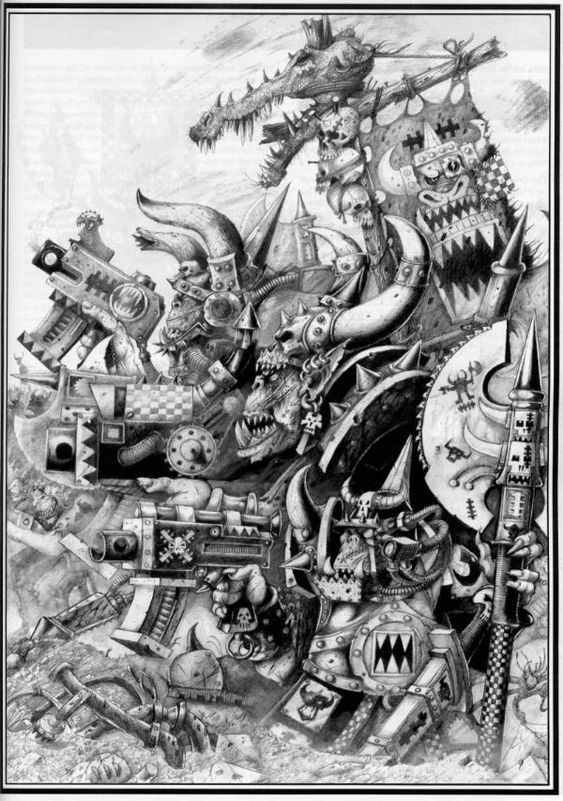Oldhammer Orks in Black & White Art

Oldhammer Orks: The Anarchic Charm of Warhammer’s Beloved Brutes
Appearance and Aesthetic
Orks in the Oldhammer era were depicted as hulking, green-skinned brutes with a uniquely exaggerated and comical appearance. Their aesthetic drew heavily from punk rock culture, with features like mohawks, piercings, and cobbled-together armor that emphasized their anarchic nature. Their vehicles and wargear were a chaotic assembly of scavenged materials, held together by luck as much as crude engineering. This ramshackle, eccentric look captured the Orks’ improvisational and reckless spirit, making them stand out visually among the factions. The combination of rugged brutality and chaotic creativity defined their look and gave them a distinctive charm.
Culture and Behavior
Oldhammer Orks were a reflection of their violent and chaotic nature, driven by a love of battle, looting, and destruction. Their society was straightforward yet brutally effective, where power was determined by sheer size and strength. The biggest and toughest Orks naturally took charge, often leading their clans in constant conflict and competition. Each clan had its own distinct personality, from the speed-obsessed Evil Sunz to the grim and stoic Goffs, adding layers of variety and depth to their culture. This diversity was mirrored in their units and playstyles, showcasing the colorful and wild spirit of Ork society.
Warfare and Tactics
When it came to warfare, Oldhammer Orks embraced brute force, overwhelming numbers, and chaotic tactics. Their armies consisted of a mix of crude infantry like Ork Boyz and elite fighters like Nobz, supported by a wild array of unpredictable war machines. Vehicles such as the iconic Battlewagon or the hilariously dangerous Shokk Attack Gun were emblematic of the Orks’ love for wild experimentation. Their strategies often prioritized speed, shock, and sheer chaos, creating a playstyle that was as thrilling as it was unpredictable. On the battlefield, Orks epitomized their mantra: “Might makes right.”
Humor and Personality
One of the most memorable aspects of Oldhammer Orks was their humor, which infused every aspect of their design and lore. The Orks were portrayed with a satirical and light-hearted tone that poked fun at the grim seriousness of the Warhammer universe. Their exaggerated facial expressions, comical miniature poses, and absurd weapons all added to their charm. Even their language, filled with crude, humorous slang, reflected their anarchic personality. This sense of humor made them a beloved faction for players who wanted to inject fun and unpredictability into their games.
A Legacy of Chaos and Fun
In the Oldhammer era, Orks stood out as a faction that combined brutality and chaos with an irresistible sense of humor and personality. Their distinctive aesthetic, rich clan culture, and unpredictable playstyle made them a favorite among players who valued creativity and fun. Despite the evolution of the Warhammer universe, the legacy of Oldhammer Orks continues to influence their modern portrayal. They remain a testament to the vibrant and eccentric creativity that defined the early years of Warhammer.

